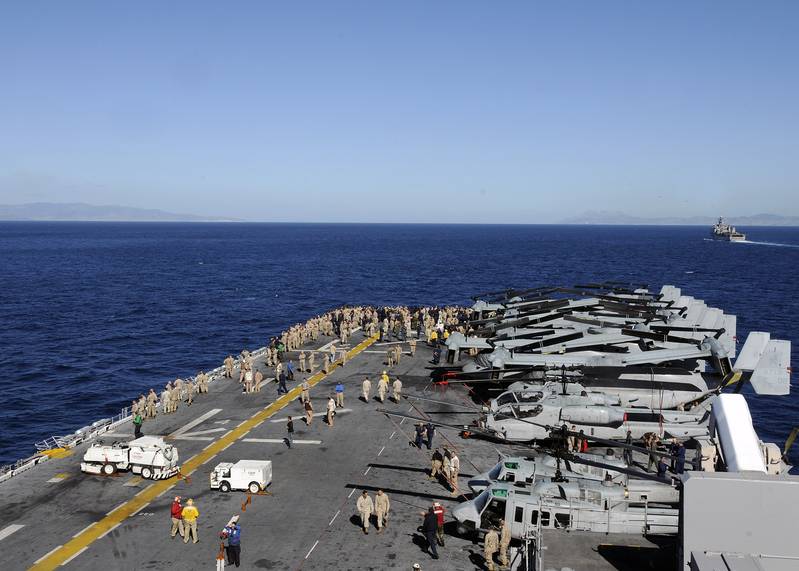
Welcome to MSW’s Scuttlebutt! Here’s the news for the day.

On Display Feature - German Frigates Hamburg and Sachsen FFG 219& 220
Crew-mate David J. Salvin (djandj) shows us that sometimes two ships are better than one with this offering of the German Frigates Hamburg and Sachsen FFG 219& 220 in this MSW Feature.

China's Project 022 Fast Attack Craft
Source: Forecast International
NEWTOWN, Conn. --- The Chinese Navy's Project 022 class is, despite its innovative hull design, a classic missile-armed fast attack craft. It is designed for the sole purpose of delivering eight anti-ship missiles to a specified naval target and has virtually no capability outside that area. Its design makes it unsuitable for patrol duties, while its short operational radius limits its applicability to maritime policing work.
In military roles, it is virtually defenseless against air attack and would have to rely on speed and agility to survive in a hostile environment. Craft in this general category were once in great vogue, but experience has shown that they are not an effective military unit outside very limited and specific areas. However, the Chinese Navy happens to have one of those limited and specific areas as a primary operational requirement. Thus, in its specific geostrategic situation, the Project 022 is a viable and effective craft.
The Chinese Navy has gone to significant lengths to reduce the investment in any single Project 022 class FAC-M to a minimum. This does not just apply to equipment standards, austere though they are, but to manpower. The Project 022 has a crew of 12 to 14 sailors, less than half that of similar craft. At a unit cost of an estimated $50 million each, the Chinese could afford both the financial and manpower commitment needed to operate a very large fleet of these craft. Construction is expected to exceed 100 hulls and may well go beyond that point.
The catamaran hull form used by the Project 022 appears to be successful, and films of the class at sea show the craft handle well. This raises the possibility that variants of the design might well be evolved to handle a wider spectrum of operational requirements. Stripping out the bulky and heavy missile tubes would provide space and weight for the equipment needed to handle rigid inflatable boats and the other equipment necessary for maritime policing operations. This would allow the Chinese to offer a low-cost and effective competitor in the offshore patrol craft sector.
Over the years, the Chinese have sold large numbers of attack and patrol craft around the world. At present some 40 coastal patrol craft and 70 missile-armed fast attack craft built in China remain in service. The Project 022 would be in an excellent position to replace the latter as they begin to wear and need to be replaced. The postulated maritime patrol craft variant of the design would be well placed to replace the former group. The export market for the Project 022 and derivatives thereof certainly exists; it is up to the Chinese to turn a potential into reality.
U.S. Second Fleet Ships Complete Successful Ballistic Missile Defense Tracking Exercise
Source: US Navy
NORFOLK, Va. --- Three Commander, U.S. Second Fleet ships successfully completed a tracking exercise Jan. 22, off the coast of Virginia using the Aegis Ballistic Missile Defense (BMD) system during Atlantic Trident 2011.
USS Monterey (CG 61), USS Ramage (DDG 61) and USS Gonzalez (DDG 66) all successfully tracked the short-range ballistic missile target that was launched from NASA Wallops Island Flight Facility in Wallops Island, Va. The target missile fell harmlessly into the Atlantic Ocean.
Monterey, an Aegis cruiser, and Ramage, an Aegis destroyer, took turns tracking and simulating engagement of the target while Gonzalez, a guided-missile destroyer, participated by tracking the target.
All three ships were able to successfully track the target, with Monterey and Ramage providing simulated target solutions that would have resulted in a successful intercept. No missiles were fired from the ships as it was a tracking exercise.
Ballistic missile defense is a Navy core mission. The Missile Defense Agency and the Navy have modified 21 Aegis BMD combatants (5 cruisers and 16 destroyers). Of the 21 ships, 16 are assigned to the Pacific Fleet and five to the Atlantic Fleet. The Secretary of Defense announced in 2010 that six more destroyers would be upgraded to the Aegis BMD capability.
Atlantic Trident 2011 is the first live Fleet Ballistic Missile Defense (BMD) exercise to take place in the Atlantic.

Naval Battle of Abtao
Today’s is the anniversary of the Naval Battle of Abtao.

USS Essex Association
Today’s website is USS Essex Association. Enjoy.
This Day in U.S. Naval History
1800 - USS Essex becomes the first U.S. Navy vessel to cross the equator.
1815 - The Board of Naval Commissioners, a group of senior officers, is established to oversee the operation and maintenance of the Navy under the direction of the Secretary of the Navy.
1955 - Ships from the 7th Fleet begin the evacuation of Chinese nationalists from the Tachen Islands.
1965 - In response to a Viet Cong attack on a U.S. barracks area in Pleiku, South Vietnam, aircraft from carriers USS Coral Sea (CV 43), USS Hancock (CV 19) and USS Ranger (CV 61) attack a North Vietnamese area near Donghoi.
1991 - Using her remotely piloted vehicle for spotting, USS Wisconsin (BB 64) pounds Iraqi artillery, electronic warfare and naval sites with her 16-inch guns. Fifty rounds sink or severely damage 15 boats, and destroy piers at Khawr al-Mufattah Marina.
Diorama Idea of the Day

Sailors and Marines aboard the amphibious assault ship USS Kearsarge (LHD 3) observe as the ship transits the Strait of Gibraltar.
Gator











